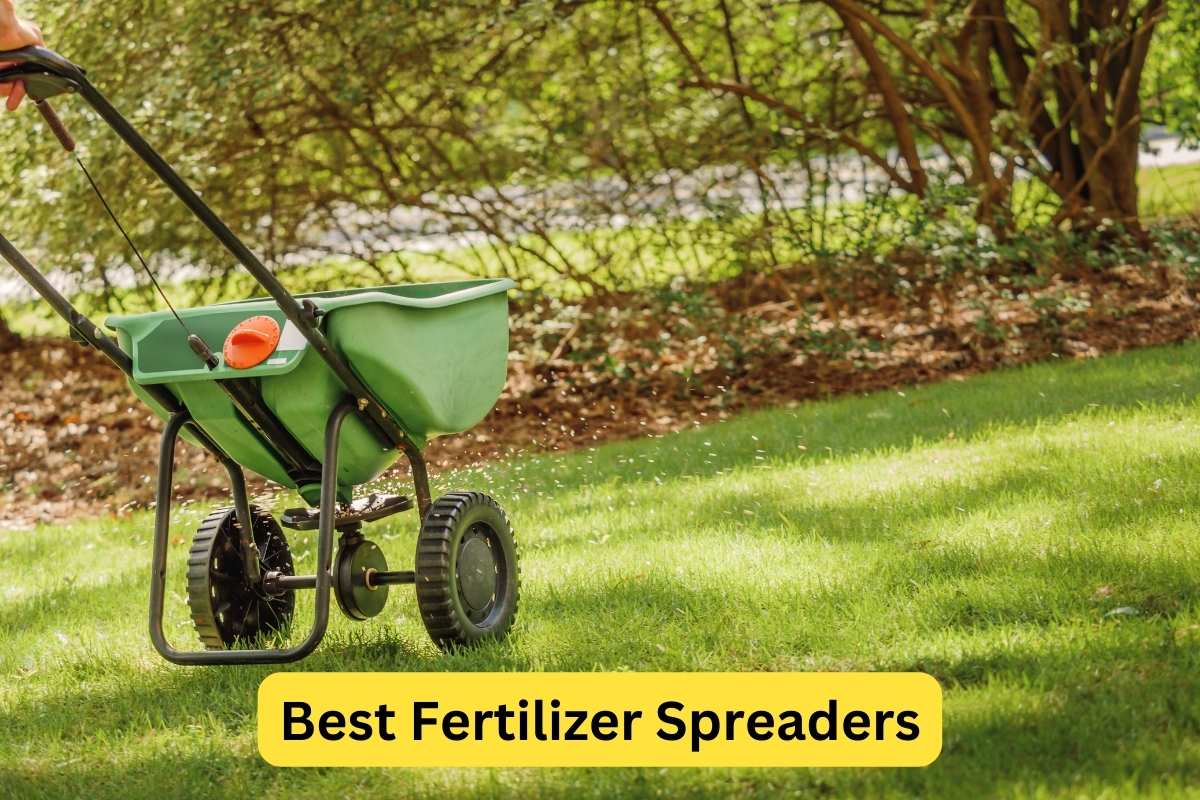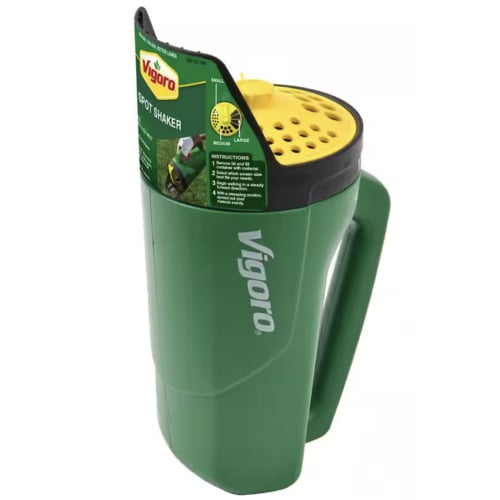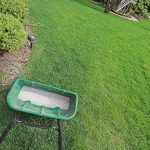
The best fertilizer spreader is the Scotts Turf Builder EdgeGuard Mini. On our list, we’ve gathered the 6 best fertilizer spreaders for all lawn sizes to ensure an even application while saving you effort.
We researched models from America’s leading lawn care retailers — Home Depot, Lowe’s, Amazon, and Walmart. After carefully comparing each one on factors like lawn size and holding capacity, we found the best fertilizer spreaders. To add even more value, every spreader on our list can also spread grass seed and other granular products, like lime and ice melt.
To help you find the best spreader for your yard, we review our top picks and include a fertilizer spreader buying guide.
- 1. Best Broadcast Spreader: Scotts Turf Builder EdgeGuard Mini
- 2. Best High-Capacity Spreader: Brinly P20-500BHDF Push Spreader
- 3. Best Drop Spreader: Agri-Fab 45-0288 Tow-Behind Drop Spreader
- 4. Best Tow-Behind Spreader: Agri-Fab 45-0463 Tow-Behind Broadcast Spreader
- 5. Best Handheld Spreader: Vigoro Hand Spot Shaker
- 6. Best Battery-Powered Spreader: Scotts Wizz Battery-Powered Spreader
1. Best Broadcast Spreader
Scotts Turf Builder EdgeGuard Mini

| What We Liked | What We Didn’t Like |
| Comes fully assembled and pre-calibrated | It’s hard to push over uneven ground |
| Affordable and lightweight | Dispersal is erratic over uneven ground |
| Consistent coverage on even ground | Some customers complain about the handle being too short |
| EdgeGuard technology that prevents spilling products into your driveway, landscape or sidewalks | |
| Foldable handles to facilitate storage | |
| Ideal for small lawns, holding up to 5,000 sq. ft. of product |
Specifications
- Handling: Walk-behind
- Holding capacity: 15 lb.
- Lawn size: Up to 5,000 sq. ft.
- Max spread width: 5 feet
- Spreader type: Broadcast
- Weight: 10.67 lb.
Our favorite fertilizer spreader for lawns from 1,500 to 5,000 square feet is the Scotts Turf Builder EdgeGuard Mini. Finding a lightweight walk-behind that’s feature-packed and efficient is tough. But this Scotts product delivers all of the above in an affordable spreader that works well on lawns and pavement.
With the EdgeGuard Mini, applying granular products to small spaces is easy. Some of the many terrific traits of this product include:
- Ready-to-use: It comes pre-calibrated and fully assembled.
- Consistent coverage: Its dual-bladed agitator and curved hopper smoothly disperse materials for even coverage.
- Precision: When activated, the EdgeGuard technology blocks the right side of the spread pattern, preventing lawn products from leaking into your driveway or sidewalks.
- Compact: It’s easy to store and maneuver with a petite frame and foldable handles.
It’s our list’s lightest push spreader, weighing just over 10 pounds. The spreader’s easy to push over flat terrain but challenging to navigate over bumpy or uneven ground. It quickly covers up to 5,000 square feet with a 15-pound holding capacity and 5-foot spread width.
Where to buy:
2. Best High-Capacity Spreader
Brinly P20-500BHDF Push Spreader

| What We Liked | What We Didn’t Like |
| 50-lb. hopper capacity, great for large yards (up to ½ acre) and heavy-duty tasks | Heavy, weighing 28 lbs. unfilled |
| Side deflector prevents spreading product on unwanted areas | Some customers consider the product overpriced |
| Pneumatic tires make maneuvering easier | |
| Fully enclosed, rust-proof hopper |
Specifications
- Handling: Walk-behind
- Holding capacity: 50 lb.
- Lawn size: 10,890 sq. ft. (1/4 of an acre) to 21,780 sq. ft. (1/2 acre)
- Max spread width: 12 feet
- Spreader type: Broadcast
- Weight: 28 lb.
Our best high-capacity lawn spreader is ideal for homeowners with larger yards who need a heavy-duty spreader. The Brinly P20-500BHDF has simple calibration settings to ensure an even spread and 12-by-3-inch pneumatic tires that make pushing it through your lawn a breeze.
Additionally, the Brinly P20-500BHDF also has a deflector that can be flipped up and out to prevent spreading your product over unwanted areas. With a large spread width of 12 feet and a load capacity of 50 lb., you’ll cover your entire lawn much faster and more efficiently. It’s a perfect option for four-season use.
Where to buy:
3. Best Drop Spreader
Agri-Fab 45-0288 Tow-Behind Drop Spreader

| What We Liked | What We Didn’t Like |
| Easy to control where it drops product | Customers complain about it being hard to calibrate and uneven distribution |
| Smooth maneuverability | Customers complain about fragile agitator blades |
| Holds up to 175 lb. of product | |
| 3-year limited manufacturer’s warranty | |
| Covers up to 40,000 sq. ft. with one load of product |
Specifications
- Handling: Tow-behind
- Holding capacity: 175 lb.
- Lawn size: 40,000 sq. ft. (approximately 1 acre)
- Max spread width: 42-inch (3.5-foot) spread
- Spreader type: Drop
- Weight: 43 lb.
The Agri-Fab 45-0288 holds up to 175 pounds of granules and has a 3.5-foot spread width, making it the perfect spreader for lawns as large as an acre.
With a durable and rust-resistant hopper, this spreader for fertilizer (or other granular materials) is equipped with 12-by-3-inch pneumatic tires that help the spreader to smoothly trail behind your riding mower or garden tractor.
Another key feature is its galvanized steel agitator that’s easy to clean and rust-resistant. And because the hopper spans the full distance between the tires, you don’t have to worry about getting product on your landscaping or pavement. The Agri-Fab 45-0288 is a reliable drop spreader that comes with a 3-year warranty.
Where to buy:
4. Best Tow-Behind Spreader
Agri-Fab 45-0463 Tow-Behind Broadcast Spreader

| What We Liked | What We Didn’t Like |
| Holds up to 130 lb. of product | Some customers complain about the product design, saying the angle of the hopper affects the product flow |
| 3-year limited manufacturer’s warranty | Customers say assembly instructions are not clear |
| Covers up to 25,000 sq. ft. with one load of product | |
| Easy-to-use universal hitch | |
| Rod control accessible from the tractor seat |
Specifications
- Handling: Tow-behind
- Holding capacity: 130 lb.
- Lawn size: 25,000 sq. ft.
- Max spread width: 12 feet
- Spreader type: Broadcast
- Weight: 29.4 lbs.
Considered the best tow-behind spreader on our list, the Agri-Fab 45-0463 is a broadcast spreader. Its 12-foot spread width ensures you can cover your lawn in no time, and the 130 lb. capacity allows you to cover 25,000 square feet in one load. It also comes with a universal hitch that can be attached to all tractors and a steel rod control accessible from your seat.
Made in the U.S., the Agri-Fab 45-0463 comes with a 3-year limited warranty, as do the other products from the brand. The 13-by-4-inch pneumatic wheels ensure the spreader will easily ride on uneven surfaces or slopes.
Where to buy:
5. Best Handheld Spreader
Vigoro Hand Spot Shaker

| What We Liked | What We Didn’t Like |
| Affordable | Not able to disperse powders |
| Easy to use | Not practical for spaces over 1,500 sq. ft. |
| Lightweight | Some customers complain about the lid’s fit and about it being hard to open and close |
| Precise application, ideal for spot treatments | |
| 3 spreading settings |
Specifications
- Handling: Handheld
- Holding capacity: 5.8 lb.
- Lawn size: Up to 1,500 sq. ft.
- Spreader type: Shaker
- Weight: 0.83 lb.
Sometimes, all you need is a simple salt-shaker-style drop spreader. And that’s why we recommend the Vigoro Hand Spot Shaker. It’s the lowest-priced spreader on our list, featuring a straightforward design that weighs less than 1 pound. With a nearly 6-pound capacity and 3 spreader settings, it’s the best drop spreader for lawns less than 1,500 square feet.
Made of high-quality plastic, the handheld drop spreader is very durable. It’s also ergonomic and small enough to fit comfortably in most users’ hands. It gives you a high level of control over where dry products drop, making applications precise.
Where to buy:
6. Best Battery-Powered Spreader
Scotts Wizz Battery-Powered Spreader

| What We Liked | What We Didn’t Like |
| Lightweight | Customers claim that you have to constantly shake it to get the fertilizer to move down |
| Trigger control that makes application easy (no hand-cranking required) | Some customers say the motor is weak |
| 5-foot spread width | |
| 4 AA batteries included | |
| EdgeGuard technology that ensures precise application |
Specifications
- Handling: Handheld
- Holding capacity: 6.25 lb.
- Lawn size: 2,500 sq. ft.
- Max spread width: 5 feet
- Spreader type: Broadcast
- Weight: 0.5 lb.
If you like the versatility of handheld spreaders, but the thought of having to hand-crank fertilizer or seed over the entire lawn gives you hand fatigue, the Scotts Wizz Battery-Powered Spreader is the solution for you. With a 5-foot maximum spread, this handheld spreader works with a one-touch control.
For out-of-the-box convenience, this spreader comes with 4 AA batteries (2 for your first use and 2 that you can keep as a backup). And for precise application, the Scotts Wizz also has your back: The EdgeGuard technology blocks the spreader’s side, preventing waste and spillage.
Where to buy:
What to Look For in a Fertilizer Spreader
Choosing the right spreader can save you a lot of time, money, and effort. Before making your purchase, consider the types of products you plan to use, the different types of spreaders, and your lawn’s size and characteristics.
What Products Can You Use with a Fertilizer Spreader?
Spreaders are handy year-round tools used to apply granular products, such as:
- Fertilizer: Most of the best lawn fertilizers are granular. They’re more cost-effective than liquid fertilizers and rarely burn grass. But you want to spread fertilizer evenly, which requires a good-quality spreader. Visit our guide on when to fertilize your lawn to see the right timing for your grass type.
See our guide on Liquid vs. Granular Fertilizer to better understand the differences between these two fertilizer types.
- Weed killer: Spreaders help you with weed control. Apply the best pre-emergent herbicides in early spring and early fall to prevent summer and winter weeds. And apply the best post-emergent herbicides anytime you want to kill existing weeds.
- Fungicide: You can treat common lawn diseases with the best lawn fungicides.
- Preventive pesticide: Prevent common lawn pests by applying pesticide in early spring, early summer, and fall.
- Grass seed: You need a seed spreader or fertilizer spreader for DIY overseeding.
- Ice melt: You also can use a fertilizer spreader to apply ice melt or salt on sidewalks and driveways.
Side note: Liquid lawn products are typically applied using a sprayer. Visit our guide to learn more on How to Apply Liquid Fertilizer to Your Lawn.
See related:
Types of Fertilizer Spreaders
Broadcast spreaders and drop spreaders are the two main types of spreaders. They differ in how they disperse material:
- Broadcast spreaders (also called rotary spreaders) pour granules from the hopper onto a rotating plate. The plate throws or “broadcasts” the material several feet in all directions. They are faster than drop spreaders but less accurate.
- Drop spreaders release granules in one spot, right below the hopper. They are more accurate than broadcast spreads because they give you better flow control. But it takes a long time to distribute the material.
Additionally, because they don’t spread the granules as much as broadcast spreaders, it is easier to get a fertilizer burn.
For a visual comparison, watch this video from Grass Daddy on broadcast vs. drop spreaders:
Broadcast and drop spreaders come in different handling styles:
- Handheld spreaders are carried in your hands, so they’re small, lightweight, and preferably used in small spaces. Handheld drop spreaders have a salt-shaker style that’s very easy to use. Although handheld broadcast spreaders are heavier and more complex, they’re quicker to cover the grass.
- Shoulder or chest-mounted spreaders are a level above handhelds, but still ideal for small spaces. Because they’re larger and heavier than the handhelds, they have shoulder or chest straps to help homeowners carry the weight.
- Walk-behind spreaders (also called push spreaders) are the best choice for most homeowners. They have wheels and a long handle, so you push them around like a push lawn mower. Because weight is easier to push than carry, they have a higher holding capacity than handheld or mounted models.
- Tow-behind spreaders (also called pull-behind spreaders) make lawn care easy for homeowners with large yards. They connect to the back of your riding lawn mower, golf cart, or ATV. Most models have large hoppers that hold a massive amount of material. As a result, it’s quick and easy to apply dry products to large lawns.
Your Lawn Size
The best type of spreader for your lawn depends on its size and characteristics.
1. Lawn Size
Before purchasing a lawn spreader, consider the size of your lawn. See our guidelines in the table below.
| Lawn Size | Best Spreader Type |
| < 1,500 sq. ft. | Handheld |
| 1,500 sq. ft. – 1/4 acre | Shoulder/Chest-Mounted |
| 1/4 acre – 1/2 acre | Walk-Behind |
| 1/2 acre – 1 acre | Walk-Behind or Tow-Behind |
| > 1 acre | Tow-Behind |
It’s also important to consider the following:
- Holding capacity: Choose a spreader that holds enough material to cover your yard so you don’t have to stop and refill in the middle of working.
- Spread width: The wider the spread, the less time it takes to cover your yard.
The table below shows the average holding capacity of spreaders by type.
| Spreader Type | Holding Capacity |
| Handheld | 5 lb. to 10 lb. |
| Shoulder/Chest-Mounted | 20 lb. |
| Walk-behind | 50 lb. to 100 lb. |
| Tow | 130 lb. or more |
2. Characteristics
Consider the general characteristics of your landscape layout:
- Lawns with many obstacles: If you have flower beds, vegetable gardens, or landscaping where you don’t want the grass’s granules (i.e., herbicides, fertilizer) touching, you should consider a drop spreader.
- Large wide-open space: If your yard has large areas of grass and few obstructions, a broadcast spreader is your easiest option.
- Uneven terrain: Larger wheels maneuver better over rough terrain.
Steel vs. Plastic Spreaders
Most fertilizer spreaders have a plastic or steel frame and a plastic hopper. However, there are a few models with steel hoppers.
Steel and plastic differ in the following ways:
- Durability: Plastic isn’t as heavy-duty as steel, so plastic hoppers must be much thicker to match steel’s durability.
- Accuracy: Push spreaders with a steel hopper tend to be more accurate, especially when comparing drop spreaders. Because plastic hoppers are thicker, the spread pattern depends on handle position. All else equal, a tall person applies much more fertilizer than a short person. This makes it challenging to apply a precise amount.
- Corrosion: Some steel is prone to rust and corrosion, but plastic and stainless steel are corrosion resistant.
- Cost: Steel costs more than plastic.
Cost of Fertilizer Spreaders
Spreader prices vary by spreader type, holding capacity, and hopper material. A steel spreader, for example, will be generally costlier than its plastic counterparts. Similarly, the bigger the spreader’s holding capacity, the more expensive it tends to be.
Because handheld spreaders are usually meant to hold smaller quantities, they tend to be the cheapest option. Push spreaders’ costs can vary widely according to its holding capacity, which can go from 15 lb. up to over 100 lb. Tow-behind spreaders tend to be the most expensive options, since they are typically designed to hold large quantities of products.
See related: How Much Does Lawn Fertilization Cost in 2025?
FAQ about Spreading Fertilizer
Here’s a step-by-step on how to clean a fertilizer spreader:
• Empty out the hopper first. Use compressed air to remove the tiny particles that are stuck in small spaces.
• Wash the spreader with soap and water, including all the small moving parts.
• Store your spreader in a dry, covered location, such as a shed or garage.
Handheld spreaders are the easiest to operate for small yards or small sections within a yard. However, they take a long time to cover an area, so they’re best for spaces less than 1,500 square feet.
Small to medium push spreaders are the easiest to use on medium-sized flat lawns because they’re typically lightweight and easy to push. However, if you have uneven terrain, a model with large pneumatic tires will be easier to maneuver.
For lawns between 1/2 acre and 1 acre, choose tow-behind or walk-behind spreaders. For yards over 1 acre, tow-behind spreaders are the best option.
When to Call a Lawn Treatment Pro
DIY lawn treatments are labor-intensive, and many of the best fertilizer spreaders cost hundreds of dollars. Thankfully, affordable lawn care is just a mouse click away. LawnStarter connects you to qualified lawn treatment pros with unbeatable prices.
We support local lawn care companies with free marketing, specialized routes, and a user-friendly mobile app. Because we save them so much time and money, they can pass that savings on to their customers. See how much money you can save this season by getting a free online quote today.
LawnStarter participates in the Amazon Services LLC Associates Program and other retailer affiliate programs. LawnStarter may earn revenue from products promoted in this article.
Main Image Credit: Scott Habermann / Adobe Stock Free / License wih Text Overlay using Canva Pro





